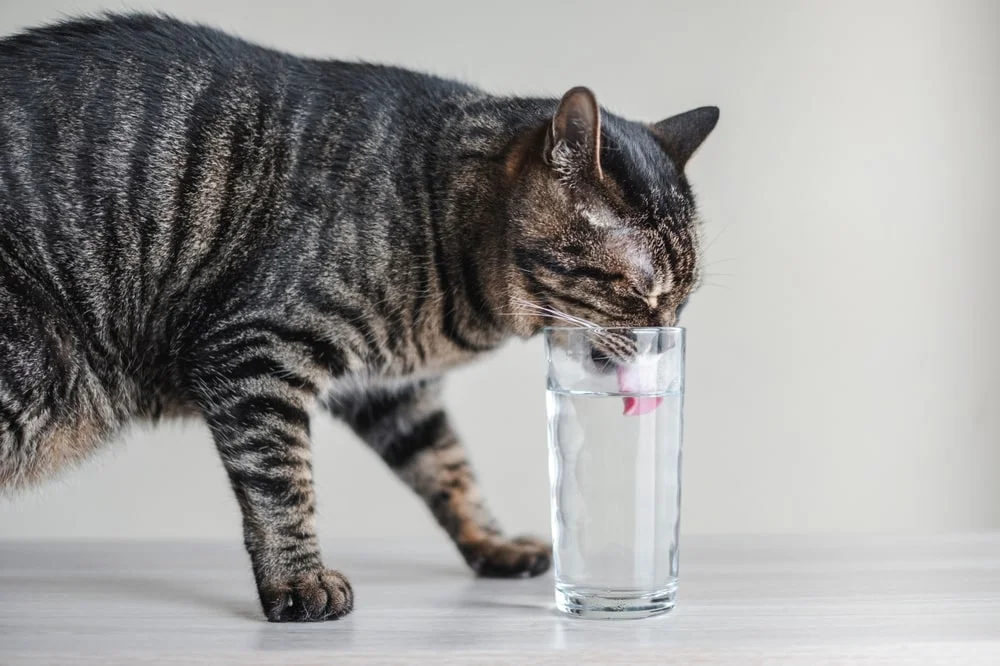PET HEALTH
As a cat owner, you’re probably pretty familiar with your feline companion’s habits, including their water drinking routine. If you notice them frequenting their water bowl or fountain more than usual, you might wonder why.
Excessive drinking could be a sign that your cat is experiencing an underlying health issue. Learn how much water cats should drink, the reasons why cats may drink a lot of water, and when it’s a good time to call the vet. Plus, see how cat insurance through MetLife Pet could help you offset the costs of potential treatment.
MetLife Pet Can Help Cover Emergency Vet Bills
See Our Prices
How Much Water Should a Cat Drink a Day?
Cats should drink about four fluid ounces of water per five pounds of lean body weight each day. This means a 10-pound cat, which is about average, should drink approximately one cup of water per day.1 Knowing this can help you figure out if your cat is drinking enough water or too much.
However, wet cat food has a higher water content than dry food. So if your cat eats wet food, they may drink less water and still get the required amount.1
Reasons Your Cat Is Drinking a Lot of Water
If you think your cat is drinking a lot of water, look for other signs and symptoms that something may be wrong. Even if their behavior doesn’t seem serious, a trip to the vet is a good idea because the reason for excessive drinking could require medical attention.
Kidney disease
A cat drinking a lot of water could be a sign of kidney disease. Many older cats develop chronic kidney disease — affecting up to 40% of cats over age 10 and 80% over age 15. When a cat has kidney disease, their kidneys are unable to filter blood effectively and make properly concentrated urine. This can cause cats to urinate more frequently and therefore drink more water.2
The first signs of cat kidney disease will likely be frequent urination and increased drinking. Other signs include lethargy, poor appetite, and weight loss.2 If you suspect your cat may be developing kidney disease, contact your vet.
Liver disease
Excessive thirst and urination are also symptoms of liver disease in cats. Livers can become diseased for many reasons, such as infections, inflammatory conditions, or toxins. One of the most notable symptoms of liver disease in cats is jaundice, which is when the skin, eyes, and gums appear yellowish.3
If you notice your cat drinking lots of water, along with other symptoms like jaundice, vomiting, abnormal bruising or bleeding, lethargy, and weight loss, a trip to the vet can help diagnose your cat’s condition.3
Diabetes
Diabetes mellitus — commonly known as simply, diabetes — is a condition that occurs when the body can’t properly produce or respond to its own insulin. This elevates blood sugar levels. Cats more commonly develop Type II diabetes, where the body doesn’t respond to the insulin it makes.4
Excessive thirst and urination are typical signs of diabetes in cats, along with weight loss despite the cat eating a normal amount.4 If you notice these symptoms, give your vet a call.
Hyperthyroidism
If you see your cat drinking a lot of water, hyperthyroidism could be the culprit. This condition is common in older cats, occurring when their bodies produce too much of the thyroid hormone. It affects a cat’s metabolism and most of their organs, especially the heart.5
Drinking more water can be a symptom of hyperthyroidism. Cats may also urinate more frequently, become restless, increase their vocalizations, and (most commonly) lose weight despite having an increased appetite.5 It’s a good idea to take your cat to the vet if you suspect hyperthyroidism, as complications can be severe.
Urinary tract infection
While more common in female cats, any cat can get a urinary tract infection (UTI). Along with drinking a lot of water, cats who develop a UTI may urinate more frequently, strain while urinating, and have bloody urine. Your vet will likely want to take a look at your cat to officially diagnose them with a UTI before prescribing antibiotics.6
Medication side effect
Some medications can lead to increased thirst in cats, causing them to drink more water. If your cat recently started taking anti-seizure drugs, steroids, diuretics, or any other medications or supplements, this could explain a change in their drinking habits.7 Check the prescription information or contact your vet to ask about this possible side effect.
Environmental factors
Certain environmental or lifestyle factors might make cats more thirsty and drink more water. Hot weather can cause cats to drink more water to stay cool and hydrated. Higher levels of activity may also lead to drinking a lot of water.6 Changing your cat’s food from wet to dry could increase their thirst levels, since dry food contains less water.1
A change in a cat’s environment or routine can cause stress, which may lead to increased water consumption.6 Work on establishing a consistent routine and stress-free environment to help regulate your cat’s water intake.
When to Take Your Cat to the Vet for Excessive Drinking
If your cat is drinking lots of water because it’s hot, they just exercised, or there was a change in diet or environment, it’s probably normal.6 But a vet visit may be warranted if the excessive drinking happens along with:8
- Lethargy
- Changes in appetite, urination, or behavior
- Weight loss
- Jaundice
- Vomiting
Whether you suspect a reason for your cat drinking a lot of water or you’re unsure, a trip to the vet can give the answers you need. Your veterinarian will likely do a physical examination of your feline friend, ask you about their symptoms, and perform diagnostic tests if needed — such as blood work, a urinalysis, and X-rays or ultrasounds.8
Treating a Cat Who Drinks a Lot of Water
Once the diagnosis for your cat’s excessive drinking is determined, a treatment plan can be created. Regardless of the reason your cat is drinking a lot of water, your vet will probably check to see if they’re dehydrated. If they are, your vet will want to do intravenous (IV) fluid therapy to get your cat back to normal hydration levels.1
Medication and other specific treatments or therapies are often prescribed to help treat health conditions like UTIs, kidney and liver disease, hyperthyroidism, and diabetes. UTIs are typically treated once each time they’re diagnosed, but these other conditions may require lifelong treatment. Diet changes could also be part of your cat’s treatment plan.8
MetLife Pet Can Help You Cover Vet Bills
Why does your cat drink so much water? There could be many reasons why your furry friend has been making more trips to their water bowl lately — many of which could require at least one trip to the vet, if not continued care. The bills for this care can be costly, which is a reason why many pet owners may choose a cat insurance policy with MetLife Pet.
Sammy, a 14-year-old cat from Illinois, was drinking a lot of water and acting restless. Her owner took her to her veterinarian, where she was diagnosed with hyperthyroidism. The vet visit and treatment cost about $360, but Sammy’s owner had an insurance policy, and MetLife Pet covered over $280 of the bill.9
You never know when your cat will begin drinking too much water, come down with an illness, or get injured. A cat insurance policy can help you take care of your feline friend’s vet care costs. Get a free quote today.


